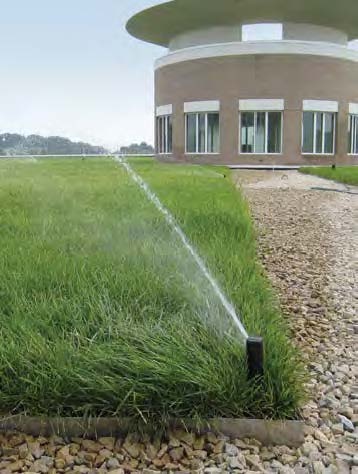Water access at the roof level is an important design consideration that is often forgotten or an afterthought in the vegetated roof design process. Access to sufficient water is one of the most important considerations for establishing and maintaining healthy vegetated roofs. After the establishment period, most extensive vegetated roofs can rely predominantly on natural rainfall with occasional supplemental watering needed when natural rainfall amounts fall short.
Sufficient Water
When supplying vegetation and warranting plant performance on Extensive Garden Roofs, Hydrotech sets minimum water availability requirements:
- Water sources (hose bibs, hydrants, irrigation, etc.) should be spaced no more than 30 meters apart
- Minimum water pressure at roof level: 240 kPa
- Minimum water volume at roof level: 30-40 LPM
Manual vs. Permanent Irrigation
Manual irrigation systems consist of hoses and nozzles that apply water to the media and plant material. Very labor intensive, manual irrigation requires the commitment of labor resources to be on the green roof on a very regular basis. Temporary irrigation systems typically consist of hoses and sprinklers connected to on-roof water sources such as hose bibs or roof hydrants.
These systems are typically used during the establishment period and removed soon after. These systems require significant labor hours during the establishment period to move and re-set sprinklers to ensure proper coverages over the green roof. Portable irrigation control units are available to create a semi-automatic system that helps to reduce the labor costs of turning on and off the irrigation system.
Permanent Irrigation
If a permanent irrigation system is being considered by the design team, Hydrotech recommends that a pop-up system be considered over a drip irrigation system for the following reasons:
 Newly installed plant materials require large and consistent amounts of water during the initial establishment periods.
Newly installed plant materials require large and consistent amounts of water during the initial establishment periods.- Drip irrigation systems cannot deliver enough lateral water to the top of the media immediately adjacent to the root zone of sedum tiles and carpets at time of installation.
- As a result, drip irrigation systems can be used, but will require additional supplemental irrigation equipment and labor to provide enough overhead water for proper plant establishment.
- Pop-up irrigation systems can more effectively simulate natural rainfall and apply water to the top surface of the media where the water is more available to the plants.
- Pop-up irrigation systems can provide water during both establishment and ongoing maintenance periods.
- Pop-up irrigation systems (properly designed) do not require supplemental systems to provide sufficient water.
- Pop-up irrigation systems must be properly designed to keep overspray to a minimum. Sprinkler head selection and patterns are crucial to a properly designed system.
For proper design and operation, a qualified irrigation designer/consultant should be consulted when designing any irrigation system.
Maintenance
It is important to note that all irrigation systems will require maintenance including:
- Spring startup
- Review of system for proper operations
- Repair of damaged sections
- Resetting spray heads for proper operation
- Fall shutdown including removal of water from system by using compressed air
A qualified irrigation designer/consultant should include a thorough maintenance plan as part of a properly designed irrigation system.


